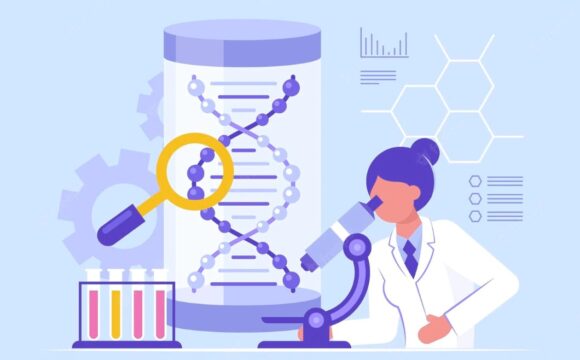Genetically modified foods. A big scientific word for food though!
They are shortly known as GM foods. Genetically modified food is food produced from organisms whose DNA has been altered through genetic engineering, also known as GMOs. Genetic engineering techniques allow the introduction of new traits as well as greater control over traits when compared to previous methods, such as selective breeding and mutation breeding. This technique helps create crops that can survive drought and help produce food that’s more nutritious. The principal transgenic crops grown commercially in the field are herbicide and insecticide-resistant soybeans, corn, cotton, and canola. Though this kind of genetic modification is used both in plants and animals, it is found more commonly in the former than in the latter.
Well, this sounds beneficial for human consumption. But still, GM foods are controversial. There’s a broad scientific consensus that the genetically modified foods currently on the market pose no more of a health risk than regular foods. Opponents argue that genetically modified crops can lead to things like the increased use of chemical herbicides, or cite problems with the fact that GMOs are owned and patented by large companies. That has led to debates over whether GMOs should be labeled or tightly regulated. Countries growing GMO crops are: Brazil, United States, Canada, South Africa, Australia, Bolivia, Philippines, Spain, Vietnam, Bangladesh, Colombia, Honduras, Chile, Sudan, Slovakia, Costa Rica, China, India, Argentina, Paraguay, Uruguay, Mexico, Portugal, Czech Republic, Pakistan and Myanmar. Approved GMO foods include herbicide-tolerant soybean, maize, canola, cotton, sugarbeet, alfalfa, and insect-resistant cotton.

How GM foods can prove to be useful?
Genetic engineering techniques have the ability to alleviate certain disorders and diseases by developing GM foods. These foods grow faster than the foods that are grown traditionally. Probably because of this, the increased productivity provides the population with more food. Moreover, these foods are a boon in places which experience frequent droughts, or where the soil is incompetent for agriculture. Genetically engineered food crops can be grown at places with unfavorable climatic conditions too. They are reported to be high in nutrients and contain more minerals and vitamins than those found in traditionally grown foods. Also, these foods are known to taste better. Another reason for people opting for genetically engineered foods is that they have an increased shelf life and hence there is less fear of foods getting spoiled quickly. If GM technology is to be used in India, it should be directed at the real needs of Indian farmers, on crops like legumes, oilseeds and fodder and traits like drought tolerance and salinity tolerance. GM foods have the potential to solve many of the world’s hunger and malnutrition problems and to help protect and preserve the environment by increasing yield and reducing reliance upon synthetic pesticides and herbicides. Crop protection is the main rationale behind this type of genetic modification. Plants that are more resistant to diseases spread by insects or viruses result in higher yields for farmers and a more attractive product. Genetically modification can also increase the nutritional value or enhance flavor. All of these factors contribute to lower costs for the consumer. They also ensure that more people have access to quality food. GMOs are a good fit for addressing some of the specific challenges.
Are they harmful??
The biggest threat caused by GM foods is that they can have harmful effects on the human body. It is believed that consumption of these genetically engineered foods can cause the development of diseases which are immune to antibiotics. As the health effects are unknown, many people prefer to stay away from these foods. Manufacturers do not mention on the label that foods are developed by genetic manipulation because they think that this would affect their business, which is not a good practice. Many religious and cultural communities are against such foods because they see it as an unnatural way of producing foods. Experts are also of the opinion that with the increase of such foods, developing countries would start depending more on industrial countries because it is likely that the food production would be controlled by them in the time to come. The main concerns involved are:
-
Allergenicity:
Transfer of genes from allergenic organisms to non-allergic organisms may take place. Foods developed using traditional breeding methods are not generally tested for allergenicity, protocols for the testing of GM foods have been evaluated by the Food and Agriculture Organization of the United Nations (FAO) and WHO. Still no allergic effects have been found relative to GM foods currently on the market.
-
Antibiotic resistance:
Gene transfer from GM foods to cells of the body or to bacteria in the gastrointestinal tract would cause concern if the transferred genetic material adversely affects human health. This would be particularly relevant if antibiotic resistance genes are transferred. Although the probability of transfer is low, the use of gene transfer technology that does not involve antibiotic resistance genes is encouraged.
-
Outcrossing:
The migration of genes from GM plants into conventional crops or related species in the wild is referred as ‘outcrossing’. This may have an indirect effect on food safety and food security. Cases have been reported where GM crops approved for animal feed or industrial use were detected at low levels in the products intended for human consumption. Several countries have adopted strategies to reduce mixing, including a clear separation of the fields within which GM crops and conventional crops are grown.
-
Cancer:
Some researchers believe that eating GMO foods can contribute to the development of cancer. They argue that because the disease is caused by mutations in DNA, it is dangerous to introduce new genes into the body.
Are they safe enough for consumption?
Well, different GM organisms include different genes inserted in different ways. This means that individual GM foods and their safety should be assessed on a case-by-case basis and that it is not possible to make general statements on the safety of all GM foods. GM foods currently available on the international market have passed safety assessments and are not likely to present risks for human health. In addition, no effects on human health have been shown as a result of the consumption of such foods by the general population in the countries where they have been approved. Continuous application of safety assessments adequate post-market monitoring should form the basis for ensuring the safety of GM foods.
Reference:
- Genetically modified foods: safety, risks and public concerns—a review. A. S. Bawa, K. R. Anilakumar. J Food Sci Technol. 2013 Dec; 50(6): 1035–1046.
- https://www. who. int/foodsafety/areas_work/food-technology/faq-genetically-modified-food/en/










